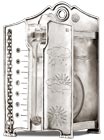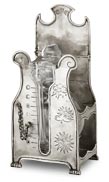One of the problems that Galileo (1564-1642) turned his attention to during the last years of his life was the impossibility of raising a column of water by more than about 9.70 metres. The fact that the column could only be lifted to that height was explained at the time as Nature's "horror vacui" (horror of vacuum) which prevented a vacuum from forming by filling the airless space with whatever was nearest to hand. Galileo explained the existence of this limit by theorising that horror vacui had a measurable force and described the highest level to which a pump could raise a column of water as the "maximum height" . Torricelli (1608-1647) solved the problem a year after the death of his master, Galileo, by studying the phenomenon with a handier apparatus, a tube filled with mercury in which the fluid did not rise more than 76 cm, thereby generating a pressure of 1 kg per cm², equivalent to that of the water column. Together with V.Viviani, he then introduced a new instrument called the barometer which measured "atmospheric pressure".



